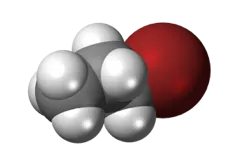
Identity of 1-bromopropane
Name 1-bromopropane (nPB)
IUPAC name 1-bromopropane, N-Propyl Bromide
CAS number 106-94-5
EC number 203-445-0
Chemical formula C3H7Br
Hazard classification of 1-bromopropane
FLAMMABLE
● H242: Heating may cause a fire
● H226: Flammable liquid and vapour
VERY HAZARDOUS TO HEALTH
● H350: May cause cancer
● H340: May cause genetic defects
● H360: May damage fertility or the unborn child
● H371: May cause damage to organs
● H304: May be fatal if swallowed and enters airways
● H334: May cause allergy or asthma symptoms or breathing difficulties if inhaled
HAZARDOUS TO THE OZONE LAYER
● EUH 059: Hazardous to the ozone layer
1-bromopropane in annex XIV of REACH
Key regulatory information Intrinsic property for which it was included in Annex XIV of REACH Toxic for reproduction (category 1B) Sunset date 4 July 2020 Latest date to submit the authorisation dossier to ECHA 4 January 2019Who is concerned by REACH authorisation? Main industries concerned Chemical, electronic
EcoMundo’s advice to succeed in your authorisation application
Recommendations for your authorisation dossier
- As the substance does not have a threshold, the Socio-Economic Analysis route will be chosen. This analysis will demonstrate that the benefits related to the granting of the authorisation outweigh the risks associated.
- The applicant will thus have to conduct a socio-economic analysis as well as the CSR and Analysis of Alternatives.
- The preferred methodology to conduct the socio-economic analysis of the authorisation application is the cost/benefit analysis.
- The creation of a dossier is usually between 6 and 18 months depending on the complexity of the dossier (intrinsic properties of the substance, complexity of the applicants’ value and production chain.
- Key elements of a successful authorisation dossier:
- A specific request with the most elements possible in relation to your activity
- Transparence and realism of the hypotheses and data as all elements produced will be challenged by the committees or stakeholders
- The “applied for use” and “non-use” scenarios are essential for the relevance of the socio-economic analysis
Planning recommendations
- The Latest Application date for this substance is 04/01/2019, the last submission window is on November 2018.
- It is therefore recommended to start the creation of the dossier immediately (september 2017).
Identity of 1-bromopropane
Name 1-bromopropane (nPB)
IUPAC name 1-bromopropane, N-Propyl Bromide
CAS number 106-94-5
EC number 203-445-0
Chemical formula C3H7Br
Hazard classification of 1-bromopropane
FLAMMABLE
● H242: Heating may cause a fire
● H226: Flammable liquid and vapour
VERY HAZARDOUS TO HEALTH
● H350: May cause cancer
● H340: May cause genetic defects
● H360: May damage fertility or the unborn child
● H371: May cause damage to organs
● H304: May be fatal if swallowed and enters airways
● H334: May cause allergy or asthma symptoms or breathing difficulties if inhaled
HAZARDOUS TO THE OZONE LAYER
● EUH 059: Hazardous to the ozone layer
1-bromopropane in annex XIV of REACH
Key regulatory information Intrinsic property for which it was included in Annex XIV of REACH Toxic for reproduction (category 1B) Sunset date 4 July 2020 Latest date to submit the authorisation dossier to ECHA 4 January 2019Who is concerned by REACH authorisation? Main industries concerned Chemical, electronic
EcoMundo’s advice to succeed in your authorisation application
Recommendations for your authorisation dossier
- As the substance does not have a threshold, the Socio-Economic Analysis route will be chosen. This analysis will demonstrate that the benefits related to the granting of the authorisation outweigh the risks associated.
- The applicant will thus have to conduct a socio-economic analysis as well as the CSR and Analysis of Alternatives.
- The preferred methodology to conduct the socio-economic analysis of the authorisation application is the cost/benefit analysis.
- The creation of a dossier is usually between 6 and 18 months depending on the complexity of the dossier (intrinsic properties of the substance, complexity of the applicants’ value and production chain.
- Key elements of a successful authorisation dossier:
- A specific request with the most elements possible in relation to your activity
- Transparence and realism of the hypotheses and data as all elements produced will be challenged by the committees or stakeholders
- The “applied for use” and “non-use” scenarios are essential for the relevance of the socio-economic analysis
Planning recommendations
- The Latest Application date for this substance is 04/01/2019, the last submission window is on November 2018.
- It is therefore recommended to start the creation of the dossier immediately (september 2017).







